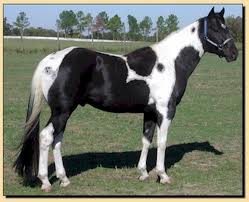|
Paint Horse
Paint Horse: The first known recorded descriptions of this horse in north America was in 1519 by the Spanish historian Diaz del Castillo, who traveled with the Spanish explorer, Hernando Cortes. The descendants of these first painted horses in America became the favorite mount of the native Indians. The "paints" with their broken patterns were easy to camouflage which aided in hunting and also helped the rider to pass undetected thru enemy territory. With the introduction of the horse, Indian tribes adopted a completely new nomadic way of life. Instead of permanent farming villages they could now follow the buffalo on their migrations. 
The modern American Paint shares a common ancestry with the American Quarter Horse and the Thoroughbred. The result is a muscular, stocky animal that is heavy but not too tall, ranging between 15 and 16 hands. This versatile horse can be found in the show ring and is also a popular trail mount.
Each Paint Horse has a "pattern" with a particular combination of white and another color. The tobiano is the most common spotting pattern, characterized by rounded markings with white legs and white across the back between the withers and the dock of the tail, usually arranged in a roughly vertical pattern and more white than dark, with the head usually dark and with markings like that of a normal horse. i.e. star, snip, strip, or blaze. The overo is a group of spotting patterns characterized by sharp, irregular markings with a horizontal orientation, usually more dark than white, though the face is usually white, sometimes with blue eyes. The white rarely crosses the back, and the lower legs are normally dark. The tovero is a spotting pattern that is a mix of tobiano and overo coloration, such as blue eyes on a dark head.
The solid is a horse otherwise eligible for registration as a Paint that does not have any white that constitutes a recognized spotting pattern.
|
